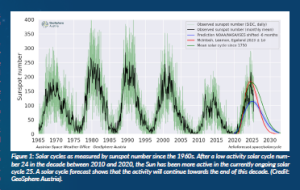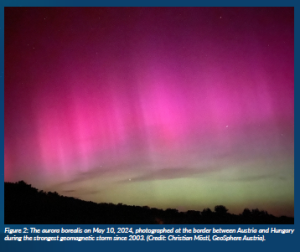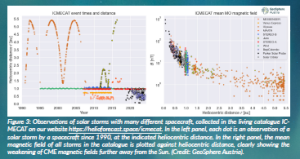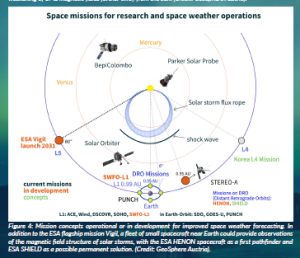Christian Möstl & Eva Weiler
Solar storms, also named ‘coronal mass ejections’ (CMEs), are the cause of one of the most spectacular natural phenomena that is of high interest to the public: the aurora borealis, also known as polar or northern lights. The occurrence of the aurora at mid-latitudes, such as central Europe, has been very rare since the early 2000s, as the Sun has since undergone an 11-year activity cycle with only a few sunspots, considerably weaker than in previous decades (Figure 1). A less active Sun means fewer and weaker CMEs impacting Earth, and thus fewer and weaker appearances of northern lights. However, the current solar cycle, which began in 2019, is significantly stronger, with sunspot counts indicating an average cycle magnitude. Consequently, in May and October 2024, the two strongest geomagnetic storms occurred since 2003.
Over the last few decades, humanity has been quite fortunate to have dodged a stronger solar cycle, as CMEs can also have a significant impact on our technological infrastructure. They disrupt satellites, interrupt signals used for global navigation satellite systems (GNSS) and, in extreme cases, can even paralyse power grids, such as during the famous 1989 solar storm that left millions of inhabitants in Quebec, Canada, without electricity for several hours. During the May 2024 storm, which had a magnitude of approximately 70% of the 1989 storm, several detrimental technological effects were observed. Farmers in the USA observed that their planting equipment lost track due to errors in the GNSS systems used for guidance, caused by ionospheric disturbances during the storm. Gladly, this storm did not produce any problems with power grids. It was certainly the most photographed aurora event in history, as millions of people around the world were able to capture the colours of the aurora with their smartphones (Figure 2).
While forecasts of the arrival time of the CMEs responsible for the May 2024 storm were quite accurate, the source of the storm consisted of five CMEs interacting with each other, which led to a complex behaviour of the interplanetary magnetic field. This made forecasts of the storm magnitude very difficult in such cases. However, due to a lucky circumstance, the STEREO-A spacecraft was in the right place to observe these storms: just a bit closer to the Sun, so it observed the storms before they arrived near Earth. However, as we saw the STEREO-A data in real time, we were unsure how reliable it was for forecasting. One of the first major results of our project was the clarification that spacecraft measurements taken closer to the Sun were accurate enough. We first need to explain, however, how the main issue in CME prediction arises.
Space weather forecasting is far less advanced than terrestrial weather forecasting. This lack of accuracy hinders many types of mitigation efforts. Our ERC Consolidator Grant project deals with possible solutions to the so-called ‘Bz problem’, which is one of the key unsolved issues in space weather forecasting. When the magnetic field in a CME points southward, a geomagnetic storm is intensified, but it is attenuated for a northward-directed field. Hence, not only the speed of a solar storm, but mainly its magnetic field direction, matters for forecasting its magnitude.
Solar storms consist of magnetic structures with higher total magnetic fields that sweep up the solar wind ahead. But these magnetic fields also often rotate smoothly and may partly or fully exhibit these southward fields as they sweep over the Earth. It is amazing that the Sun creates these magnetic cores of CMEs with a structure that has a clear order. Nature has given us this ordered field as a key to unlocking a better way to forecast these storms, but we have yet to understand how to use it.
Many space probes are currently orbiting the Sun in the heliosphere, which makes it possible for the first time to measure uncharted territory very close to the Sun with the NASA Parker Solar Probe, or observe the Sun’s poles with the ESA Solar Orbiter mission. In our project, we hunt for CME observations by all of these missions and create an openly available living catalogue (Figure 3). This catalogue is then used in many scientific contexts, such as training data for artificial intelligence methods to automatically detect CMEs in spacecraft data, or to derive empirical laws on CME evolution from this dataset.
Missions like STEREO-A also provide real-time data streams of the main plasma and magnetic field parameters of the solar wind, including the southward magnetic field. If the solar wind is observed by a spacecraft that is further ahead between the Sun and the Earth, we can use these data and combine them with basic knowledge of solar storm physics to produce a forecast at Earth. The latter has been achieved during the project for the first time in real time with the spacecraft Solar Orbiter (Laker et al., 2024) for a CME in March 2022, and with STEREO-A for the May 2024 superstorm (Weiler et al., 2025). In Weiler et al. (2025), we show how future space missions could extend the warning time for extreme solar storms.
Although we can use space telescopes to detect solar storms early and estimate when they will arrive at Earth, the crucial information about their magnetic field orientation remains unclear until CMEs reach the so-called Lagrange Point 1 (L1). The L1 point is located about 1.5 million kilometres or 1/100 of an astronomical unit closer to the Sun than Earth. The problem for timely space weather forecasts is that a solar storm only takes about 10 to 60 minutes to travel from L1 to Earth, which is too little time to take comprehensive protective measures.
As mentioned earlier, we can sometimes use other spacecraft data to produce forecasts for Earth and extend the warning time. Unfortunately, there is currently no continuous space mission that is in a fixed position closer to the Sun than L1, and scientists must hope for such fortunate spacecraft constellations. The reason there is no such continuous space mission yet is the difficulty of positioning a spacecraft in such an orbit, which would be unstable and incompatible with Kepler’s laws. One promising solution is the concept of ‘distant retrograde orbits’ (DROs). Several satellites would be sent into an Earth-like orbit, which would differ slightly in their eccentricity from that of the Earth’s orbit. When orbiting the Sun, these space probes would then alternate between being in front of and behind the Earth. By using several satellites, it would be possible to ensure that at least one space probe is always located between the Sun and the Earth, thereby providing crucial measurements earlier than those from probes at L1 (Figure 4).
In May 2024, however, we got lucky and, in addition to the usual measurements from spacecraft at L1, the superstorm was also recorded by the STEREO-A spacecraft. This makes it the first superstorm to be measured both by spacecraft at L1 and by another probe in space science history. Specifically, at the time of the event, STEREO-A was between the Earth and the Sun, about four times closer to the Sun than L1, which is exactly in the area that will also be relevant for future DRO missions. Thanks to this favourable position of STEREO-A, the superstorm was detected two and a half hours earlier than by space probes at L1 (Figure 5).
This event, therefore, provided a unique opportunity to test the predictive potential of future DRO missions. A key issue for these missions is the optimum
distance to Earth: on the one hand, the aim is to achieve the longest possible warning time, while on the other hand, the accuracy of the forecast must be maintained. Although STEREO-A in this case was significantly further away from Earth than L1, we were able to show together with scientists from Conrad Observatory of the GeoSphere Austria, the University of Graz, NASA and the University of New Hampshire (USA) that the strength of the May 2024 storm could be reliably determined even from this distance—an important result for the development of future space weather missions (e.g. the ESA HENON mission and the ESA SHIELD mission concept).
The findings from the May 2024 event so far emphasise that the intensity of solar storms can also be estimated by space probes at greater distances from Earth than L1. In particular, satellites on a DRO could significantly increase warning time, thereby creating valuable time to better protect critical infrastructure. This would be a decisive advance in space weather forecasting and could help to better control the risks of extreme solar storms in the future.
References
Laker, R., Horbury, T.S., O’Brien, H., Fauchon‐Jones, E.J., Angelini, V., Fargette, N., Amerstorfer, T., Bauer, M., Möstl, C., Davies, E.E., Davies, J.A., Harrison, R., Barnes, D. and Dumbović, M. (2024) ‘Using Solar Orbiter as an upstream solar wind monitor for real time space weather predictions’, Space Weather, 22(2), e2023SW003628. doi: 10.1029/2023SW003628.
Weiler, E., Möstl, C., Davies, E.E., Veronig, A.M., Amerstorfer, U.V., Amerstorfer, T., Le Louëdec, J., Bauer, M., Lugaz, N., Haberle, V., Rüdisser, H.T., Majumdar, S. and Reiss, M. (2025), First observations of a geomagnetic superstorm with a sub‐L1 monitor, Space Weather, 23(3), e2024SW004260. doi: 10.1029/2024SW004260.
Project summary
Space weather forecasting is not as sophisticated or advanced as terrestrial weather forecasting. Solar storms lead to the strongest geomagnetic disturbances in the Earth’s magnetic field, but their magnitude is impossible to predict longer than up to one hour in advance. This project aims to solve the problem of predicting their magnetic field structure in near‐Earth space.
Project partners
Improving this key issue would improve the forecasts for surges of currents in power grids on the ground, reduce the errors in global navigation systems, or better predict the radiation environment for astronauts and flight crews. It would also enable much improved forecasts for the aurora, which will be appreciated by millions of people around the world.
Project lead profile
Dr Christian Möstl is the head and founder of the Austrian Space Weather Office at the national weather service GeoSphere Austria. He is a space scientist working on heliospheric weather forecasting, focusing on the transition from basic research to real-time forecasts. He is the recipient of a Marie Curie fellowship, the EGU Arne Richter Award and an ERC Consolidator Grant.
Project contacts
PI Dr Christian Möstl
Head of Austrian Space Weather Office, GeoSphere Austria
Reininghausstrasse 3, 8020 Graz
Email: christian.moestl@geosphere.at
Web: helioforecast.space
Web: geosphere.at/en
Bluesky: @aswogeosphere.bsky.social
Bluesky: @chrisoutofspace.bsky.social
Funding disclaimer
This project has been funded by the European Research Council (ERC) under the European Union’s Horizon Europe research and innovation programme – grant agreement number 101042188.
Views and opinions expressed are however those of the author(s) only and do not necessarily reflect those of the European Union or the ERC. Neither the European Union nor the granting authorities can be held responsible for them.
Figure legends
Figure 1: Solar cycles as measured by sunspot number since the 1960s. After a low activity solar cycle number 24 in the decade between 2010 and 2020, the Sun has been more active in the currently ongoing solar cycle 25. A solar cycle forecast shows that the activity will continue towards the end of this decade. (Credit: GeoSphere Austria).
Figure 2: The aurora borealis on May 10, 2024, photographed at the border between Austria and Hungary during the strongest geomagnetic storm since 2003. (Credit: Christian Möstl, GeoSphere Austria).
Figure 3: Observations of solar storms with many different spacecraft, collected in the living catalogue IC-MECAT on our website https://helioforecast.space/icmecat. In the left panel, each dot is an observation of a solar storm by a spacecraft since 1990, at the indicated heliocentric distance. In the right panel, the mean magnetic field of all storms in the catalogue is plotted against heliocentric distance, clearly showing the weakening of CME magnetic fields further away from the Sun. (Credit: GeoSphere Austria).
Figure 4: Mission concepts operational or in development for improved space weather forecasting. In addition to the ESA flagship mission Vigil, a fleet of small spacecraft near Earth could provide observations of the magnetic field structure of solar storms, with the ESA HENON spacecraft as a first pathfinder and ESA SHIELD as a possible permanent solution. (Credit: GeoSphere Austria).
Figure 5: A simulation of the fronts of five solar storms that caused the May 2024 super geomagnetic storm with the ELEvo model developed at GeoSphere Austria. The storms arrived by about 2.5 hours earlier at the STEREO-A spacecraft, which was 12° west of Earth and closer to the Sun, demonstrating the usage of spacecraft at these positions for improved space weather forecasting (Credit: Eva Weiler, GeoSphere Austria).






